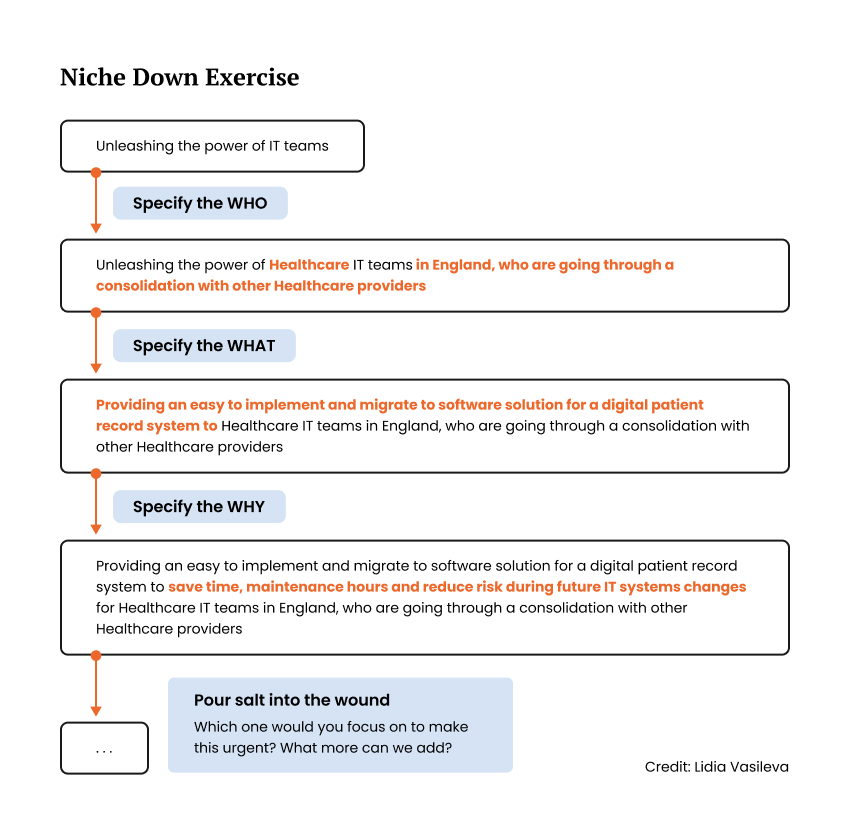
Turbo Tax is one of the top-selling tax software solutions in the world for a reason. They understand their clients don’t have a CPA certification, are probably stressed while filling out the forms, and are almost definitely confused by all the IRS speak coming at them.
Taxes are complex and the consequences for getting them wrong can be huge. So Turbo Tax’s tactic isn’t to make their customers masters of tax law. Instead, they walk users through the intimidating but necessary process of filing your taxes as smoothly and clearly as possible.
Lidia Vasileva, a VMware Solution Engineer, prioritizes effective customer communication over showcasing her expertise. Lidia shared how she breaks down complex ideas into simple bite sizes in her DEMOFEST 2023 presentation.
The Curse of Knowledge
As you progress in your career, it’s easy to fall under “The Curse of Knowledge.” Especially for those with very technically inclined minds. As you learn more about the subject, the more you want to delve deep into every feature. You forget where your own education of the product started.
Even the most highly skilled solution consultant has to start at the beginning when learning about a new product. Now think about this from the customer’s perspective. In addition to being newly exposed to your offering, they might not even have the technical background to understand everything without explanation.
Pre sales serve as trusted advisors because they verify if the solution will work for the buyer’s issue. They don’t require flawless slides or a detailed overview. They simply want you to clearly explain why this is the ideal solution for them.
As Lidia puts it, “Our role is to help potential customers understand why buying our products is going to make their lives better. Your one goal is to not confuse them.”
Clear Not Clever
Early on in her career, Lidia found she was not getting the engagement and reactions she expected from her presales demos.
“I thought I’m doing something wrong, I need to do more. So I did. I made all my slides pixel perfect, the animation speed had exact timing, the diagrams needed to be sharp. Yet, nothing really changed.”
Lidia connected with her customers by focusing on the improvements they could expect from her solution. Every piece of technology should help businesses make money, save money, and reduce risk. Anything extra the customer won’t really care about.
Niche Down
Niching down is the practice of removing all vagueness and generalities from your language. You add as many specifics as you can until your audience knows exactly what your mission is.
For example, let’s take the all too common phrase, “Unleashing the power of IT teams.” That sentence doesn’t tell you much. Yes, it lets you know it involves IT teams, but what power are they unleashing? What does unleashing this power even do?
To clarify things, go into detail about WHO, WHAT, and WHY. WHO are you supporting? WHAT do you support in their processes? WHY do they need to do this now?
Don’t shy away from pointing out pain points. In fact, you should “pour salt into the wound” and tell them exactly what they are missing out if they don’t implement your solution.
For Lidia, the process goes as follows.

Using general or vague statements is going to alienate your audience. They either won’t understand what you’re offering or won’t resonate with your message.
Lidia says, “Niching down is key to getting buyers to understand that 1) you understand them and 2) they don’t need to tune out what you’re saying. You’re being very clear, not trying to be clever by sounding poetic or creative. You’re being surgically precise about what you’re trying to solve.”
So What?
Sometimes, the way you explain things doesn’t matter. The customer simply doesn’t care about what you’re saying. Before you talk about a feature or subject you need to make sure you know the answer to the question, “So what?”
In addition to the business reasons they should be interested in your solution, there are emotional reasons customers should care, but you’ll have to be the one to point them out. Let them know what your product will do for them.
When you tell the buyers why they should care, include things like:
- So it could provide you unseen information on your key services
- So you can see data in near real time
- So you can make better troubleshooting steps
- So you can implement better design changes
- So you make the most important product decisions
- So it can save you your time
- So it can reduce risk of things going wrong so your boss is not angry at you for screwing stuff up
- So what so you can go home early on a Friday

Lidia points out, “If you keep on asking “So what?” until you get to the point you can’t anymore, then you know your customer can actually resonate with you because you’ve answered all of their concerns and questions before they even came up.”
If you don’t know why a topic is important to this customer, then the customer definitely won’t think this topic is important.
Explain it to a 5-year Old
It might seem that if you oversimplify your guided product tour, you won’t be taken seriously. But think of it from the flip side. How will the customer view you if your explanation is too complex? They might leave confused and unsure about your offering.
A common saying goes, “If you can’t explain it simply, you don’t understand it well enough.” If a 5 year old can’t understand your presentation, then it’s not clear enough. These are highly technical things you’re explaining to an audience that has a varying level of knowledge and experience. You have to be able to communicate with all of them effectively.
Lidia tested this theory out in real life, “I found it very hard at the beginning to actually explain to folks the value of what I do and why I actually get paid the money I get paid. I have a much younger sister who’s seven. I use her as the person I explain these things to. I figured out a way to explain what we do by explaining to her how some people buy apples from the shop and applying that to digital presales.”

Lidia says, “At the end of the day, someone who helps people buy complex things by explaining how the complex things works better than AEs or product development teams alone. If you can explain yourself clearly, you’re definitely doing something right.”
Lidia thought removing technical jargon and exhaustive corporate overview slides would have resulted in her ending up on the chopping block. But then she realized she wasn’t getting the results she wanted by trying to be the smartest in the room, and switch a simpler buyer enablement like approach.
When she shifted her focus to explaining these technical ideas plainly and clearly, Lidia saw an immediate improvement in the way customers reacted toward her presentations. “A confused mind always says No.” Lidia explains.
Customers don’t move forward with the deal because they are super impressed with your sales demo and your knowledge, they move forward when they can clearly understand and communicate the value of the solution for their business.
